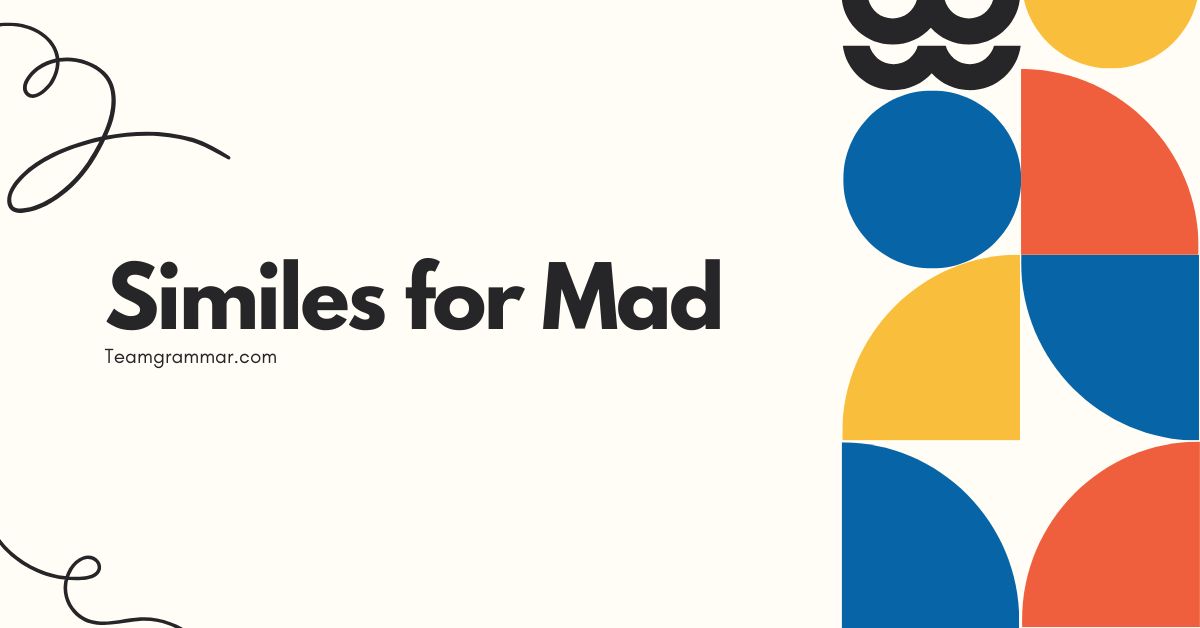43 Similes for Mad: Mastering Figurative Language in English
Understanding how to use similes effectively is crucial for enhancing your descriptive writing and adding vivid imagery to your language. Similes allow you to draw comparisons between dissimilar things, making your expressions more engaging and relatable.
This article provides a comprehensive guide to using similes for the emotion of “mad,” exploring various examples, structural elements, and practical exercises. Whether you’re an English language learner, a creative writer, or someone looking to improve their communication skills, this resource will equip you with the knowledge and tools to master the art of using similes to convey anger and frustration.
Table of Contents
- Introduction
- Definition of Simile
- Structural Breakdown of Similes
- Categories of Similes for ‘Mad’
- Examples of Similes for Mad
- Usage Rules for Similes
- Common Mistakes with Similes
- Practice Exercises
- Advanced Topics in Similes
- FAQ: Frequently Asked Questions
- Conclusion
Introduction
Similes are powerful tools in the English language, enabling writers and speakers to create vivid and relatable descriptions. By comparing one thing to another using words like “like” or “as,” similes enhance understanding and add depth to expressions.
This article focuses on using similes to describe the emotion of “mad,” offering a comprehensive guide to understanding, constructing, and effectively using these figurative comparisons. Mastering similes for ‘mad’ allows for more nuanced and impactful communication, making your language both expressive and precise.
This article is designed for English language learners, creative writers, and anyone looking to enhance their descriptive abilities. Whether you are preparing for an exam, working on a writing project, or simply aiming to improve your everyday communication, the knowledge and exercises provided here will help you master the art of using similes to express anger and frustration effectively.
By the end of this guide, you will be able to create your own impactful similes and recognize them in various contexts.
Definition of Simile
A simile is a figure of speech that compares two unlike things using the words “like” or “as.” The primary function of a simile is to create a vivid image or make a concept more understandable by associating it with something familiar. Unlike metaphors, which state that something *is* something else, similes only suggest a resemblance or similarity.
Similes are essential in both literature and everyday speech for adding color, depth, and clarity to descriptions.
In the context of emotions, similes can be particularly effective in conveying the intensity and nature of feelings. For example, saying someone is “as mad as a hornet” provides a stronger and more immediate sense of their anger than simply saying they are angry.
The use of familiar imagery helps the audience connect with the emotion being described, making the communication more impactful. Understanding the nuances of similes allows for more precise and effective expression in various forms of communication.
Classification of Similes
Similes can be classified based on the type of comparison they make. Some similes focus on physical attributes, while others emphasize behavior or abstract qualities.
Understanding these classifications can help in crafting more specific and effective similes.
- Physical Similes: These compare physical characteristics or appearances. Example: “As red as a beet” (describing someone’s flushed face when mad).
- Behavioral Similes: These focus on actions or behaviors. Example: “Like a raging bull” (describing someone’s aggressive behavior when mad).
- Abstract Similes: These compare abstract qualities or feelings. Example: “As bitter as gall” (describing the feeling of resentment when mad).
Function of Similes
The primary function of a simile is to enhance description and understanding through comparison. Similes serve several key purposes in communication:
- Clarification: They make complex or abstract ideas more understandable by relating them to something familiar.
- Emphasis: They intensify the emotional impact of a description.
- Imagery: They create vivid mental images that engage the reader or listener.
- Engagement: They make writing or speech more interesting and memorable.
Contexts of Similes
Similes are used in a wide range of contexts, from literature and poetry to everyday conversation and advertising. Their versatility makes them a valuable tool in various forms of communication.
- Literature: Used to enrich descriptions, develop characters, and create mood.
- Poetry: Used to evoke emotions, create rhythm, and add layers of meaning.
- Everyday Speech: Used to make conversations more engaging and expressive.
- Advertising: Used to make products more appealing and memorable.
Structural Breakdown of Similes
Similes have a specific structure that includes the subject being described, the comparison word (“like” or “as”), and the object or concept to which it is being compared. Understanding this structure is essential for creating effective and grammatically correct similes.
The basic formula for a simile is: Subject + Comparison Word + Object/Concept. The subject is the thing being described, the comparison word establishes the similarity, and the object/concept provides the point of comparison.
For example, in the simile “He was as mad as a wet hen,” “He” is the subject, “as” is the comparison word, and “a wet hen” is the object/concept.
Elements of a Simile
A simile consists of three key elements:
- Subject: The person, thing, or idea being described.
- Comparison Word: Typically “like” or “as,” indicating the comparison.
- Object/Concept: The thing to which the subject is being compared, sharing a similar quality.
Patterns in Similes
Similes often follow specific patterns to create emphasis and clarity. These patterns can vary depending on the context and desired effect.
- As + Adjective + As: This pattern is used to emphasize a specific quality. Example: “As furious as a storm.”
- Like + Noun: This pattern directly compares the subject to a noun. Example: “Mad like a dog with a bone.”
- Verb + Like + Verb: This pattern compares actions or behaviors. Example: “Fumed like a volcano.”
Rules for Constructing Similes
To create effective similes, it’s important to follow a few basic rules:
- Ensure a Clear Comparison: The connection between the subject and object should be evident.
- Use Appropriate Language: The language should be vivid and engaging, fitting the context.
- Avoid Clichés: Try to avoid overused similes that have lost their impact.
Categories of Similes for ‘Mad’
Similes for ‘mad’ can be categorized based on the intensity, behavior, and physical manifestations of anger. Understanding these categories can help you choose the most appropriate simile for a given situation.
Intensity-Based Similes
These similes describe the degree of anger, ranging from mild annoyance to extreme rage. They help convey the severity of the emotion.
- Mild Anger: “As irritated as a mosquito bite.”
- Moderate Anger: “As frustrated as a traffic jam.”
- Extreme Rage: “As furious as a hurricane.”
Behavior-Based Similes
These similes focus on the actions and behaviors exhibited when someone is angry. They provide insight into how the anger is expressed.
- Aggressive Behavior: “Like a raging bull.”
- Passive-Aggressive Behavior: “As sharp as a tack.”
- Explosive Behavior: “Like a volcano erupting.”
Physical Manifestation Similes
These similes describe the physical signs of anger, such as a flushed face, clenched fists, or trembling voice. They help create a vivid image of the person’s anger.
- Flushed Face: “As red as a beet.”
- Clenched Fists: “Like a tightly wound spring.”
- Trembling Voice: “As shaky as a leaf in the wind.”
Examples of Similes for Mad
The following tables provide extensive examples of similes for ‘mad,’ categorized by different aspects of anger. These examples will help you understand how to create and use similes effectively.
General Anger Similes
This table includes similes that describe anger in a general sense, without focusing on specific behaviors or physical manifestations. These similes are versatile and can be used in various contexts.
| Simile | Explanation |
|---|---|
| As mad as a hornet | Describes someone who is extremely angry and easily provoked. |
| Like a bear with a sore head | Describes someone who is grumpy and easily irritated. |
| As furious as a storm | Describes intense and uncontrolled anger. |
| Mad like a wet hen | Describes someone who is extremely annoyed and agitated. |
| As angry as a caged animal | Describes someone who feels trapped and is expressing their frustration through anger. |
| Like a boiling pot | Describes anger that is building up and about to explode. |
| As irate as a customer with bad service | Describes someone who is extremely displeased and expressing their anger. |
| Mad as a hatter | Describes someone who is completely irrational with anger. |
| Like a cornered rat | Describes someone who is desperate and lashing out in anger. |
| As bitter as gall | Describes the feeling of deep resentment and anger. |
| As indignant as a wrongly accused person | Describes someone who is angry because they feel unjustly treated. |
| Like a shaken soda bottle | Describes anger that is building up and about to explode. |
| As livid as a bruise | Describes intense anger that is visible and palpable. |
| Mad like a dog with a bone | Describes someone who is fiercely protective and easily angered. |
| As wrathful as an avenging angel | Describes someone who is seeking revenge in anger. |
| Like a ticking time bomb | Describes someone whose anger is building up and about to explode. |
| As enraged as a bull in a china shop | Describes someone who is destructive and out of control with anger. |
| As cross as two sticks | Describes someone who is generally irritable and easily angered. |
| Like a volcano about to erupt | Describes anger that is building up and about to explode violently. |
| As furious as a betrayed lover | Describes the intense anger felt when betrayed. |
| As mad as a wet cat | Describes someone who is uncomfortable and extremely annoyed. |
| Like a storm brewing | Describes anger that is gradually increasing in intensity. |
| As incensed as a citizen facing injustice | Describes someone who is deeply angered by unfair treatment. |
| Mad like a hornet’s nest stirred with a stick | Describes a situation where anger is easily provoked and widespread. |
| As resentful as a neglected child | Describes the anger born out of feeling ignored and unloved. |
Behavioral Anger Similes
This table focuses on similes that describe the behaviors associated with anger, such as shouting, pacing, or throwing things. These similes help illustrate how anger manifests in actions.
| Simile | Explanation |
|---|---|
| Like a raging bull | Describes someone who is charging forward aggressively with anger. |
| Shouting like a banshee | Describes someone who is screaming loudly and intensely out of anger. |
| Pacing like a caged tiger | Describes someone who is restless and agitated with anger. |
| Snapping like a turtle | Describes someone who is reacting defensively and aggressively with anger. |
| Fuming like a dragon | Describes someone who is emitting visible signs of anger, like smoke. |
| Stomping like an elephant | Describes someone who is moving heavily and angrily. |
| Growling like a wolf | Describes someone who is making low, guttural sounds of anger. |
| Bellowing like a bullhorn | Describes someone who is shouting loudly and forcefully. |
| Charging like a rhino | Describes someone who is moving forward aggressively and forcefully. |
| Roaring like a lion | Describes someone who is shouting loudly and powerfully. |
| Slamming doors like thunder | Describes someone who is expressing anger through loud and forceful actions. |
| Clenching fists like vices | Describes someone who is physically expressing their anger through tight grips. |
| Trembling like a leaf | Describes someone whose body is shaking with anger. |
| Spitting venom like a snake | Describes someone who is speaking harshly and bitterly. |
| Glaring like a hawk | Describes someone who is staring intensely and angrily. |
| Storming off like a child | Describes someone who is leaving abruptly and angrily. |
| Hissing like a cat | Describes someone who is expressing anger through sharp, hissing sounds. |
| Puffing up like a blowfish | Describes someone who is trying to appear bigger and more intimidating. |
| Ranting like a madman | Describes someone who is speaking wildly and incoherently with anger. |
| Weaving like a drunkard | Describes someone who is unsteady and disoriented with anger. |
| Barking like a dog | Describes someone who is speaking sharply and aggressively. |
| Swiping like a clawing cat | Describes someone who is acting aggressively, ready to strike. |
| Flailing like a drowning man | Describes someone who is wildly struggling with anger. |
| Spinning like a top | Describes someone who is disoriented and overwhelmed by anger. |
| Quivering like jelly | Describes someone who is shaking uncontrollably with anger. |
Physical Appearance Similes
This table includes similes that describe the physical appearance of someone who is angry, such as a flushed face, narrowed eyes, or tense muscles. These similes help create a visual image of the person’s anger.
| Simile | Explanation |
|---|---|
| As red as a beet | Describes someone whose face is flushed with anger. |
| Eyes narrowed like slits | Describes someone who is staring intently and angrily. |
| Face like thunder | Describes someone who has a dark and angry expression. |
| Muscles tense like steel cables | Describes someone who is physically rigid with anger. |
| Veins bulging like ropes | Describes someone whose veins are visible due to increased blood pressure from anger. |
| Jaw clenched like a vise | Describes someone who is holding their jaw tightly shut with anger. |
| Voice like gravel | Describes someone whose voice is rough and strained with anger. |
| Skin pale as death | Describes someone whose face has lost color due to shock or anger. |
| Hands balled into fists like rocks | Describes someone who is clenching their fists tightly with anger. |
| Forehead furrowed like a plowed field | Describes someone who is frowning deeply with anger. |
| Lips pressed into a thin line | Describes someone who is holding their mouth tightly shut with anger. |
| Nostrils flaring like a bull’s | Describes someone whose nostrils are widening with anger. |
| Cheeks flushed like roses | Describes someone whose cheeks are red with anger. |
| Eyebrows drawn down like storm clouds | Describes someone whose eyebrows are lowered in an angry scowl. |
| Gaze like daggers | Describes someone who is looking at someone else with intense anger. |
| Teeth gritted like sandpaper | Describes someone who is grinding their teeth together with anger. |
| Breath coming in ragged gasps | Describes someone who is breathing heavily and unevenly with anger. |
| Sweat beading on the brow like dew | Describes someone who is sweating due to the intensity of their anger. |
| Stance rigid as a statue | Describes someone who is standing stiffly with anger. |
| Appearance as menacing as a gargoyle | Describes someone who looks intimidating and threatening with anger. |
| Complexion blotchy like a map | Describes someone whose skin is unevenly colored due to anger. |
| Face contorted like a mask | Describes someone whose facial expression is twisted with anger. |
| Hair disheveled like a bird’s nest | Describes someone whose hair is messy and unkempt due to agitation. |
| Appearance as formidable as a fortress | Describes someone who looks unyielding and powerful in their anger. |
| Bearing as intimidating as a thundercloud | Describes someone whose presence suggests imminent anger and disruption. |
Usage Rules for Similes
Using similes effectively requires understanding certain rules and guidelines. This section covers the key rules for proper simile usage, including clarity, relevance, and avoiding clichés.
Clarity in Similes
A good simile should create a clear and understandable comparison. The connection between the subject and the object should be evident to the audience.
Ambiguous or confusing similes can detract from the intended meaning.
For example, “He was as mad as a politician” is less clear than “He was as mad as a hornet.” The latter provides a more specific and immediate sense of the person’s anger because the image of a hornet is universally associated with being easily provoked and intensely angry.
Relevance in Similes
The comparison made in a simile should be relevant to the subject being described. The object or concept used in the simile should share a quality or characteristic that is pertinent to the subject’s context.
Irrelevant similes can be distracting and ineffective.
For instance, describing someone’s anger as “as hot as ice” is contradictory and irrelevant because heat and ice are opposing concepts. A more relevant simile would be “as hot as a furnace,” which aligns with the idea of intense heat and anger.
Avoiding Cliches
Cliches are overused similes that have lost their impact and originality. While they may be easy to use, they often fail to create a vivid or engaging image.
It’s best to avoid cliches and strive for more creative and original comparisons.
Examples of clichéd similes include “as mad as hell” and “as angry as a bull.” While these similes are commonly used, they lack the freshness and impact of more original comparisons. Instead, try creating similes that are unique and tailored to the specific context.
Exceptions to the Rules
Like all grammar rules, there are exceptions to the rules of simile usage. In some cases, deliberately breaking these rules can create a unique effect or add humor to the writing.
For example, using an intentionally absurd or contradictory simile can be a form of humor. However, these exceptions should be used sparingly and with a clear understanding of their intended effect.
The goal is to enhance the writing, not to confuse or distract the audience.
Common Mistakes with Similes
Even experienced writers can make mistakes when using similes. This section addresses some of the most common errors and provides examples of correct and incorrect usage.
Confusing Similes and Metaphors
One common mistake is confusing similes with metaphors. While both are figures of speech that make comparisons, similes use “like” or “as,” while metaphors directly state that something *is* something else.
Incorrect Simile: “He was a raging bull.” (This is a metaphor.)
Correct Simile: “He was like a raging bull.”
Correct Metaphor: “He was a raging bull.”
Using Weak Comparisons
Another common mistake is using weak or ineffective comparisons that don’t create a strong image or convey the intended meaning.
Weak Simile: “He was as mad as a person.”
Strong Simile: “He was as mad as a hornet.”
Overusing Similes
While similes can enhance writing, overusing them can make the text feel cluttered and distracting. It’s important to use similes judiciously and only when they add value to the description.
Overuse: “He was as mad as a hornet, like a raging bull, and as furious as a storm.”
Better: “He was as mad as a hornet, his fury like an unleashed storm.”
Practice Exercises
The following exercises will help you practice using similes for ‘mad.’ Each exercise includes a set of questions and their corresponding answers. Work through these exercises to reinforce your understanding and improve your skills.
Exercise 1: Identifying Similes
Identify the similes in the following sentences. For each simile, identify the subject, comparison word, and object/concept.
| Question | Answer |
|---|---|
| 1. She was as mad as a wet hen. | Subject: She; Comparison Word: as; Object/Concept: a wet hen |
| 2. He roared like a lion. | Subject: He; Comparison Word: like; Object/Concept: a lion |
| 3. Her face was as red as a beet. | Subject: Her face; Comparison Word: as; Object/Concept: a beet |
| 4. He stormed off like a child. | Subject: He; Comparison Word: like; Object/Concept: a child |
| 5. The veins in his neck bulged like ropes. | Subject: The veins; Comparison Word: like; Object/Concept: ropes |
| 6. She was as furious as a betrayed lover. | Subject: She; Comparison Word: as; Object/Concept: a betrayed lover |
| 7. He was pacing like a caged tiger. | Subject: He; Comparison Word: like; Object/Concept: a caged tiger |
| 8. They were as indignant as a wrongly accused person. | Subject: They; Comparison Word: as; Object/Concept: a wrongly accused person |
| 9. The door slammed like thunder. | Subject: The door; Comparison Word: like; Object/Concept: thunder |
| 10. He was as mad as a hatter. | Subject: He; Comparison Word: as; Object/Concept: a hatter |
Exercise 2: Completing Similes
Complete the following similes with an appropriate object or concept to describe anger.
| Question | Answer |
|---|---|
| 1. He was as mad as __________. | a hornet |
| 2. She shouted like __________. | a banshee |
| 3. His face was as red as __________. | a beet |
| 4. He was stomping like __________. | an elephant |
| 5. Her voice was like __________. | gravel |
| 6. He was as furious as __________. | a storm |
| 7. She was pacing like __________. | a caged tiger |
| 8. He was as bitter as __________. | gall |
| 9. The door slammed like __________. | thunder |
| 10. He was as enraged as __________. | a bull in a china shop |
Exercise 3: Creating Similes
Create your own similes to describe the following scenarios related to anger.
| Scenario | Example Answer |
|---|---|
| 1. Someone who is extremely irritated by a minor inconvenience. | As irritated as a mosquito bite. |
| 2. Someone who is expressing their anger through harsh words. | Spitting venom like a snake. |
| 3. Someone whose anger is building up and about to explode. | Like a volcano about to erupt. |
| 4. Someone who is physically shaking with anger. | Trembling like a leaf in the wind. |
| 5. Someone who is staring intensely and angrily. | Glaring like a hawk. |
| 6. Describe the feeling of deep resentment and anger. | As bitter as gall. |
| 7. Describe someone who is lashing out in anger. | Like a cornered rat. |
| 8. Describe someone who is fiercely protective and easily angered. | Mad like a dog with a bone. |
| 9. Describe the facial expression of someone who is very angry. | Face like thunder. |
| 10. Describe someone who is moving forward aggressively and forcefully. | Charging like a rhino. |
Advanced Topics in Similes
For advanced learners, exploring more complex aspects of similes can further enhance their writing skills. This section covers advanced topics such as extended similes, metaphorical similes, and the use of similes in different genres.
Extended Similes
An extended simile is a simile that is developed over several lines or sentences, providing a more detailed and elaborate comparison. This technique allows for a richer and more nuanced description.
Example: “His anger was like a wildfire, starting small and unnoticed, then quickly spreading and consuming everything in its path, leaving behind only ashes and destruction.”
Metaphorical Similes
A metaphorical simile combines the elements of both similes and metaphors, creating a comparison that is both explicit and symbolic. This technique can add layers of meaning and depth to the writing.
Example: “He was as mad as a caged bird, its wings clipped, its song silenced, its spirit yearning for freedom.”
Similes in Different Genres
The use of similes can vary depending on the genre of writing. In poetry, similes are often used to create evocative imagery and convey emotions.
In prose, they can be used to clarify complex ideas or add color to descriptions. In technical writing, similes should be used sparingly and with a focus on clarity and precision.
FAQ: Frequently Asked Questions
This section addresses some frequently asked questions about using similes, providing clear and concise answers to common queries.
- What is the difference between a simile and a metaphor?
A simile compares two things using “like” or “as,” while a metaphor states that one thing *is* another. Similes suggest a resemblance, while metaphors assert an identity.
- Why are similes important in writing?
Similes enhance descriptions, clarify complex ideas, evoke emotions, and make writing more engaging and memorable. They add depth and color to the text.
- How can I avoid using clichéd similes?
Strive for originality by thinking of unique and specific comparisons. Consider the particular context and choose images that are fresh and relevant.
- Can I use similes in formal writing?
Yes, but use them judiciously. Ensure they add value to the description and do not detract from the clarity or professionalism of the writing.
- What makes a good simile?
A good simile is clear, relevant, and engaging. It creates a vivid image or makes a concept more understandable by drawing a meaningful comparison.
- How many similes should I use in a piece of writing?
There is no set number, but use them sparingly and only when they enhance the text. Overusing similes can make the writing feel cluttered.
- Can I use similes to describe abstract concepts?
Yes, similes can be particularly effective in clarifying abstract concepts by relating them to something more concrete and familiar.
- What if my simile doesn’t make sense to the reader?
Ensure the comparison is clear and relevant. If necessary, provide additional context or explanation to help the reader understand the intended meaning.
- How can I improve my ability to create similes?
Practice regularly, read widely, and pay attention to the similes used by other writers. Experiment with different comparisons and solicit feedback from others.
- Is it okay to use similes in technical writing?
Similes can be used in technical writing, but they should be used sparingly and with a focus on clarity and precision. Avoid using similes that are too figurative or open to interpretation.
- What are some examples of overused similes for “mad”?
Common clichéd similes for “mad” include “as mad as hell,” “as angry as a bull,” and “as mad as a hatter.” These similes are overused and lack originality.
- How can I make my similes more creative and impactful?
Think outside the box and consider unusual or unexpected comparisons. Use vivid language and imagery to create a strong and memorable impression.
Conclusion
Mastering similes is a valuable skill that can significantly enhance your descriptive writing and communication abilities. By understanding the structure, types, and usage rules of similes, you can create vivid and impactful comparisons that bring your writing to life.
This article has provided a comprehensive guide to using similes for the emotion of “mad,” offering numerous examples, practical exercises, and advanced topics to help you deepen your understanding and improve your skills.
Remember to focus on clarity, relevance, and originality when crafting similes. Avoid cliches and
, and practice regularly to hone your abilities.
Whether you are an English language learner, a creative writer, or someone looking to improve their communication skills, the knowledge and tools provided in this article will empower you to use similes effectively and express yourself with greater precision and impact. Keep exploring, experimenting, and refining your skills to unlock the full potential of similes in your writing and speech.







